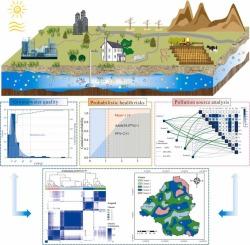揭开易受污染农业城市地下水综合管理的神秘面纱:一种结合概率风险、源头分摊和人工智能的协同方法
IF 12.2
1区 环境科学与生态学
Q1 ENGINEERING, ENVIRONMENTAL
引用次数: 0
摘要
地下水对农业城市至关重要,但集约化耕作和化肥的使用增加了污染风险,尤其是非致癌健康危害。本研究揭示了地下水中污染物的来源、对健康的影响以及此类城市的针对性策略。研究分析了 115 个地下水样本,主要地下水化学类型为 HCO₃-Na-Ca。发现 Mg²⁺、HCO₃-、F-、总硬度 (TH) 和 Mn 严重超标,其中 HCO₃- 和 Mg²⁺ 几乎在所有样本中都超标。平均环境水质综合指数(CEWQI)为 100.68,表明研究区域的地下水水质总体良好。优质水主要分布在水库和河流附近,而城市和东部地区的水质相对较差。不适合饮用的地下水比例较低。蒙特卡罗风险评估显示,F- 和 NO₃- 对成人和儿童都有非致癌风险,其中 NO₃- 的潜在健康风险更高。正矩阵因式分解(PMF)模型确定,地下水污染主要来自自然地质过程和人类活动,其中农业是主要的人为因素。基于人工智能的分区战略强调,工业区和高氟区是需要加强预防和控制措施的关键区域。本文章由计算机程序翻译,如有差异,请以英文原文为准。

Unravelling integrated groundwater management in pollution-prone agricultural cities: a synergistic approach combining probabilistic risk, source apportionment and artificial intelligence
Groundwater is vital for agricultural cities, but intensive farming and fertilizer use have increased contamination risks, particularly for non-carcinogenic health hazards. This study reveals the sources of contaminants in groundwater, their health impacts, and targeted strategies in such cities. The study analyzed 115 groundwater samples, with the main groundwater chemical type being HCO₃-Na·Ca. Significant exceedances were found in Mg²⁺, HCO₃−, F−, total hardness (TH), and Mn, with HCO₃− and Mg²⁺ surpassing standards in nearly all samples. The average Comprehensive Environmental Water Quality Index (CEWQI) was 100.68, indicating that overall groundwater quality in the study area is good. High-quality water is mainly found near reservoirs and rivers, while urban and eastern regions have relatively poorer water quality. The proportion of groundwater unsuitable for drinking is low. Monte Carlo risk assessments revealed that F− and NO₃− pose non-carcinogenic risks to both adults and children, with NO₃− presenting a higher potential health risk. The Positive Matrix Factorization (PMF) model identified that groundwater pollution primarily results from natural geological processes and human activities, with agriculture being the major anthropogenic factor. AI-based zoning strategies highlighted industrial areas and high-fluoride zones as critical areas requiring enhanced prevention and control measures.
求助全文
通过发布文献求助,成功后即可免费获取论文全文。
去求助
来源期刊

Journal of Hazardous Materials
工程技术-工程:环境
CiteScore
25.40
自引率
5.90%
发文量
3059
审稿时长
58 days
期刊介绍:
The Journal of Hazardous Materials serves as a global platform for promoting cutting-edge research in the field of Environmental Science and Engineering. Our publication features a wide range of articles, including full-length research papers, review articles, and perspectives, with the aim of enhancing our understanding of the dangers and risks associated with various materials concerning public health and the environment. It is important to note that the term "environmental contaminants" refers specifically to substances that pose hazardous effects through contamination, while excluding those that do not have such impacts on the environment or human health. Moreover, we emphasize the distinction between wastes and hazardous materials in order to provide further clarity on the scope of the journal. We have a keen interest in exploring specific compounds and microbial agents that have adverse effects on the environment.
 求助内容:
求助内容: 应助结果提醒方式:
应助结果提醒方式:


